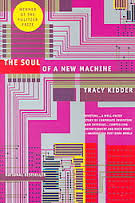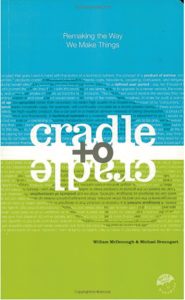Monthly Archives: May 2016
Book Review- The Soul of a New Machine
The Soul of a New Machine
by Tracy Kidder, 1981
Maria has her students read this book in Computer Systems class. So I decided to read it. It certainly provides good insight into hardware/software engineers. How they act. Their temperaments. Their biases. Their need for ‘interesting’ or ‘creative’ work and their willingness to reinvent the wheel so that it can be created ‘here’. Having played a similar role at my job, I can say that the depiction is pretty accurate. The 35 year old book is still relevant today.
That being said, one of my least favorite things in the world is to read other people’s code. A short logic jump would say that I don’t particularly like to debug or help people debug. As such, reading about other people debugging was not my favorite subject matter ever.
The story focuses upon a new 32-bit microcomputer being built at Data General. Tracy Kidder became embedded in the development group and followed their actions for about 1-2 years. Data General declined in the 80’s and was bought by EMC in 1999. A more recent version of ‘writer gets embedded with development team’ is Scott Rosenburg’s Dreaming in Code.
Teaching Kids to Shoot Basketball One-Handed
A lot of kids seem to have odd shooting mechanics in basketball. While playing yesterday, I was holding a towel to wipe my face with my non-dominant hand. I was still able to guide the ball on the shot with the towel in my hand (with my dominant hand doing the shooting), but I wouldn’t have been able to do that if I was a two-handed shooter, like some kids.
Idea: If you want to learn to shoot one-handed, hold something in your non-dominant hand while shooting. A small towel is probably about the right size.
Links 20160524
US produced more oil (and twice as much oil+gas) as Saudi Arabia in 2015. #winning. But for electricity, we’re really focused on renewables lately.
Great description of P vs. NP:
MGM Grand willing to pay $87M to exit utility agreement to access cleaner/cheaper power.
Guns replaced with selfie sticks. Just for fun after those serious links.
Links 20160523
Google will guesstimate how much solar power your roof could provide. Now available for most Indiana houses.
Just plan 2 starters for each Reds game. I really like this idea. The Reds need to evaluate a lot of young rotation arms and their bullpen is a dumpster fire.
Links 20160520
I think we should stop defending against vending machines, too. Though I’m a little worried about the talk of getting rid of NOFORN. Do we really trust the Kiwi’s enough?
Book Review- Cradle to Cradle
Cradle to Cradle: Remaking the Way We Make Things
by Michael Braungart and William McDonough, 2002
Short read about how everyone could do better in their product design. In our disposable culture, we’re used to throwing things away after use. At best, we recycle. This book points out the waste of this approach. Throwing away traps useful minerals and materials in a landfill. Recycling typically means down-cycling, whereby a product is turned into something less useful after recycling (think about how recycled paper is never fully white and thus is not as useful for reading). The book’s authors argue that with upfront thought, designers could craft products that are beneficial both during use and after use has ended. If the remnants of the product are easily turned into a new product, then the product is more environmentally responsible, more useful, and more sustainable. Luckily, these benefits can often be obtained at a lower cost than traditional manufacturing, though some significant design insight may be necessary.
The book’s title, Cradle to Cradle, alludes to a circular product world (a closed-loop supply chain) instead of the more typical and linear Cradle to Grave.
I listened to this book from my library via the hoopla app while on my way home from the POMS conference.
Links 20160519
Links 20160518
That’s why our pictures of the future always seem to resemble the present, only more so.
From Content by Cory Doctorow:
We make the future in much the same way as we make the past. We don’t remember everything that happened to us, just selective details. We weave our memories together on demand, filling in any empty spaces with the present, which is lying around in great abundance. In Stumbling on Happiness, Harvard pscyh prof Daniel Gilbert describes an experiment in which people with delicious lunches in front of them are asked to remember their breakfast: overwhelmingly, the people with good lunches have more positive memories of breakfast than those who have bad lunches. We don’t remember breakfast—we look at lunch and superimpose it on breakfast.
We make the future in the same way: we extrapolate as much as we can, and whenever we run out of imagination, we just shovel the present into the holes. That’s why our pictures of the future always seem to resemble the present, only more so.


